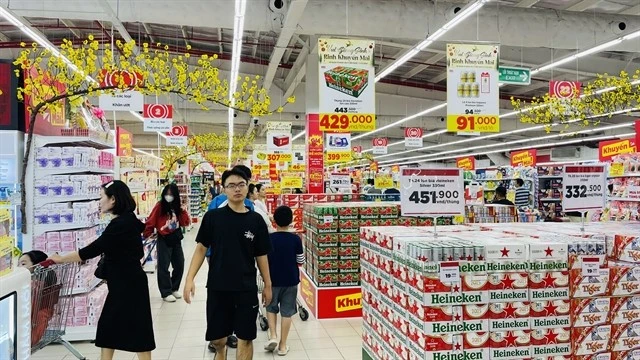Vietnamese retail industry expects bright future ahead
Vietnam’s retail industry is experiencing a period of remarkable growth, fuelled by favourable economic conditions and evolving consumer behaviour.

Vietnam’s retail industry is experiencing a period of remarkable growth, fuelled by favourable economic conditions and evolving consumer behaviour.
With a young and dynamic population, rising incomes and increasing urbanisation, the sector is emerging as one of the most promising engines for economic expansion in the coming years.
Tien Phong Securities Corporation projected the retail market in Vietnam to grow at an impressive rate of 12.05% between 2024 and 2029.
This robust trajectory is attributed to a burgeoning middle class, widespread adoption of digital payment systems and the rapid expansion of modern retail formats.
The rise in consumer confidence and disposable incomes further cements the retail sector's pivotal role in the nation’s economic recovery and growth.
Vietnam's demographic structure is critical to the retail industry's momentum. With a population exceeding 100 million, over 70% are under the age of 40, forming a consumer base that is tech-savvy, urban-oriented, and aspirational.
By 2025, the country’s GDP per capita is expected to surpass 5,000 USD, marking a significant milestone to stimulate consumer spending further.
Hoang Xuan Trung, Head of Corporate Clients at Citi Vietnam, this demographic advantage, coupled with an increasingly affluent middle class, is set to drive retail demand for years to come.
Dang Thuy Ha, Director of Customer Behaviour Research at NielsenIQ Vietnam, also highlights the growing consumer focus on not just basic needs but also quality-of-life enhancements, a shift that offers lucrative opportunities for retailers to diversify their offerings.
Key drivers of retail growth
The evolution of the country's retail industry can be attributed to several interrelated factors.
Tien Phong Securities said that the expansion of retail networks has brought modern shopping experiences to underserved areas. Supermarkets, convenience stores and online platforms are increasingly penetrating rural markets, offering consumers a more accessible and efficient alternative to traditional retail channels.
Additionally, the surge in digital payments reflects the growing integration of technology into daily life.
Close to 40% of consumers now use banking apps for shopping transactions, underscoring a shift towards cashless societies. This trend aligns with the government’s push to promote digital transformation, enhancing both convenience and transparency in retail transactions.
The country’s expanding middle class, projected to account for 26% of the population by 2026, also represents a significant driver of consumption. Estimates suggest that an additional 23.2 million people will join this demographic by 2033, creating vast opportunities for growth across all retail segments.
Vietnam's favourable labour demographics, with a majority of its population in the working age group and a high participation rate of women in the workforce, ensure sustained consumer spending across categories.
Shifting consumer trends
Consumer preferences in Vietnam are undergoing a rapid transformation.
Health and sustainability are becoming central to purchasing decisions, with increasing demand for eco-friendly and high-quality products. Shoppers are also showing greater loyalty to trusted brands, signalling a shift from price-sensitive behaviour to value-driven consumption.
Leading retail enterprises are positioning themselves to capitalise on the sector’s recovery and expansion.
Companies like FPT Retail (FRT), Mobile World Investment Corporation (MWG), Digiworld (DGW), Masan Group (MSN) and Phu Nhuan Jewelry JSC (PNJ) are leveraging their strengths to adapt to changing market conditions.
For MWG, strategic restructuring and operational efficiency have set the stage for a strong performance in 2024 and beyond.
The company’s initiatives to enhance its grocery chain, Bach Hoa Xanh, and consumer electronics brand, Erablue, are expected to yield significant results as the economy recovers and urbanisation progresses.
Similarly, Digiworld anticipates robust growth as foreign direct investment inflows bolster the economy, leading to higher consumer incomes and confidence.
Policy measures such as a 2% reduction in VAT for specific goods and services are also expected to stimulate spending, further benefiting retail players.
Mordor Intelligence predicts a 12.1% annual Compound Annual Growth Rate (CAGR) for Vietnam's retail and consumer services sector from 2024 to 2029. Retail enterprises still have room for growth.
Nguyen Viet Duc, head of Digital Business at VPBank Securities, expected that retail stocks will rebound due to escalating demand, enhanced consumer spending and the overall economic recovery momentum./.








